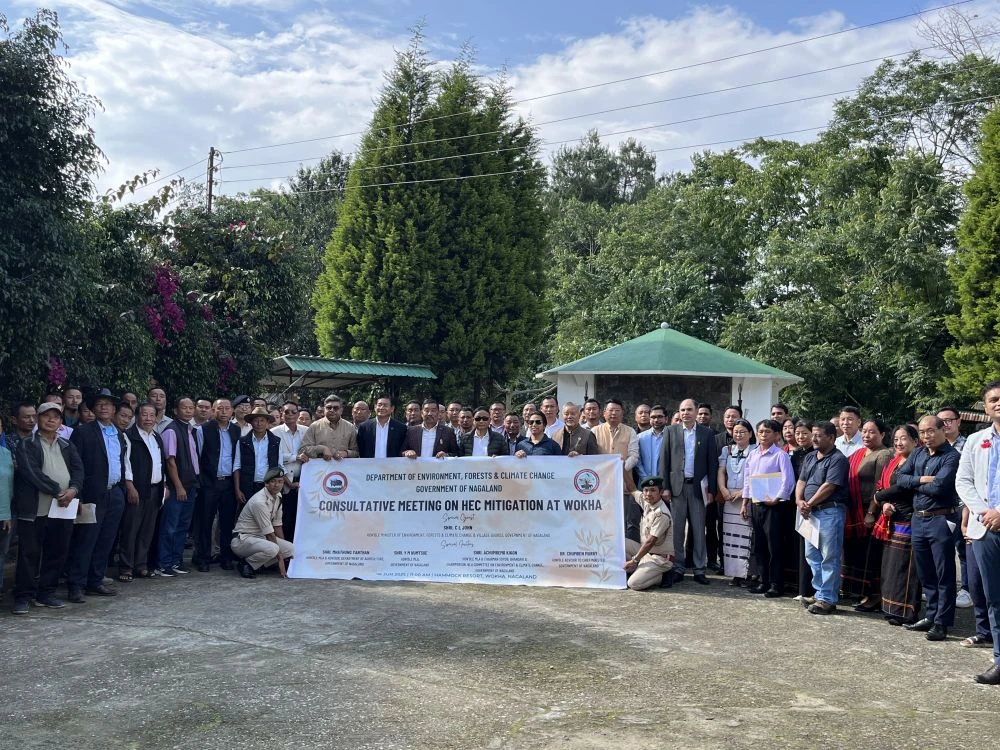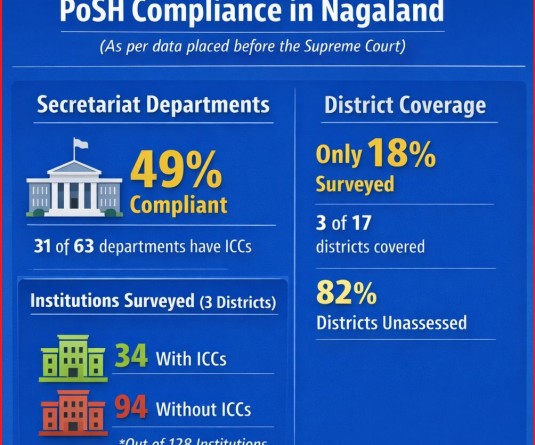
Leaders, forest officials, and experts gather in Wokha to confront the growing conflict
Morung Express News
Wokha | June 6
Wokha district is emerging as the epicentre of human-elephant conflict in Nagaland, with an estimated 200 elephants now residing permanently in the area, affecting at least 89 villages. At a high-level consultative meeting held in Wokha on June 6, state ministers, MLAs, forest officials, and wildlife experts acknowledged the scale of the crisis and called for urgent, coordinated measures—including compensation reform, contraceptive use, and possible elephant relocation—to address the growing conflict that is devastating local livelihoods and straining state resources.
Advisor to the Department of Agriculture, Mhathung Yanthan today informed that 89 villages in Wokha district are directly impacted by elephant incursions. He pointed out that Wokha hosts the largest number of elephants in Nagaland, with around 200 elephants having made the district their permanent residence.
In his constituency, which includes 21 villages, residents have long struggled with the destruction of crops, plantations, and properties due to elephant movement. He expressed concern about the inadequacy of compensation provided to the affected villagers, many of whom have yet to receive financial assistance despite the hardships they have endured.

The Advisor was speaking at the consultative meeting on Human & Elephant Conflict Mitigation held at the Hammock Resort in Wokha on June 6.
Awareness, compensation, and field presence
Yanthan noted that the lack of awareness and education on human-elephant conflict in local communities was contributing to retaliatory attitudes towards wildlife. "People fear wildlife because they lack the knowledge or skills to understand and deal with it effectively," Yanthan explained. He advocated for greater community education and sensitisation on wildlife behaviour to help reduce conflicts.
Yanthan recommended that more personnel be deployed to carry out not only monitoring activities but also awareness programmes, community training, and the establishment of early warning systems to mitigate conflicts.
His first recommendation was the establishment of a streamlined mechanism to ensure timely and adequate compensation for families and individuals affected by elephant-related damages or tragedies.
He also called for strengthening field presence and community outreach, particularly by deploying more regular staff in the affected areas. This would include conducting awareness programmes, offering community training, and setting up early warning systems to prevent human-elephant conflict.
Yanthan further welcomed the proposal to convert the Doyang Forest Division into a Wildlife Division, which he described as a positive step towards improving wildlife conservation efforts in the region.
Resource constraints
Minister CL John acknowledged that the issue of human-elephant conflict had become a significant burden for the department, yet assured that concerted efforts were underway to find a lasting solution.
He stated that the relocation of elephants was not feasible due to the sheer size of the animals and the limitations of the department’s resources. He reiterated that the department would continue to approach the issue with seriousness and dedication, focusing on measures such as birth control for elephants.
He also stressed the importance of enhancing the training of forest guards, highlighting the issue of a significant number of retirements within the force, with around 160 to 170 out of 300 sanctioned posts currently vacant. He assured that additional forest guards would be deployed in the Bhandari region, with the aim of gradually alleviating the conflict.
Rising elephant population
Dr. Chumben Murry, Advisor to the Chief Minister shared that in 2009–10, Wokha was home to around 60 elephants. By 2017, the population had increased to between 150 and 180 elephants. Fast forward to 2023, and the number has surged to approximately 200, representing a more than 200% increase in just a decade. This population boom is not just a concern for wildlife authorities but for the community at large.
"The elephant population, especially in Wokha district, has become critically significant—not in a positive sense, but due to the risks and pressures it poses," Dr. Murry stated.
A key point raised during the meeting was the introduction of contraceptive devices for elephants. "Considering that nearly 200 of the 400 elephants in the region are tuskers—male elephants—the reproductive potential is high," Dr. Murry added.
"Unchecked, the population could continue to grow exponentially. The contraceptive method, if implemented effectively, could be a necessary step in controlling this population boom."
Relocation and
environmental strain
MLA Achumbemo Kikon raised concerns about the district’s ability to sustain over 200 elephants, which he argued was beyond its capacity. He proposed the relocation of around 180 elephants as a long-term measure to alleviate the strain on Wokha's resources. "The pressure on the region is immense, and farmers are bearing the brunt," Kikon lamented. "Despite working tirelessly, their crops are often destroyed just before harvest by elephant incursions."
"We need to think of solutions that consider both population density and the region's geographical constraints," he said. "Relocation is one potential solution, but it requires careful planning and execution."
He also expressed concern about environmental degradation, urging local authorities to address the unchecked release of septic tank waste into rivers. "Untreated waste from Kohima and Wokha is being carried downstream to the Doyang area, leading to serious environmental consequences," Kikon warned.
MLA YM Humtsoe said "Blaming the elephants will not bring solutions. They are simply searching for food and survival." Humtsoe advocated for a compassionate approach to dealing with elephants, calling for collective cooperation from all sectors of society.
Mitigation strategies
Vineet Kumar, Deputy Commissioner of Wokha and Chairman of the District Disaster Management Authority (DDMA), pointed out: "This is not just a problem for the authorities to solve; it requires the active participation of the public."
Vedpal Singh, IFS mentioned that Nagaland is home to about 440 elephants, with approximately 200 residing in Wokha, Mokokchung, and Zunheboto districts. Since 2018, the state has witnessed the tragic deaths of 15 elephants and 5 human lives due to conflict. He explained the physical and electronic barriers currently in use, such as trenches, solar fencing, e-Eye systems, and bee hive fencing, are part of the ongoing efforts to mitigate the conflict. Additionally, strategies like alternative livelihoods, compensation, and the use of contraceptives are under consideration, though the matter is pending before the Supreme Court.
He also shared the department’s efforts to tackle the issue, including the preparation of mitigation plans submitted to the Ministry of Environment, Forests & Climate Change (MoEFCC) and collaboration with WCS on the "Grain for Grain" scheme. He highlighted the proposal to convert the Doyang Forest Division into a Wildlife Division.
The department has received funding from MoEFCC, including Rs 1.5 lakh for the preparation of a regional action plan and Rs 80 lakh for a study by WIL under the Project Elephant fund. However, Singh pointed out several challenges, such as inadequate funds, insufficient manpower (with half of the Forest Guard posts vacant), and systemic issues, including a delay in recruitment and indifference from local authorities. In conclusion, Singh emphasised that the success of any mitigation plan relies heavily on human cooperation and timely intervention by all stakeholders. "The single most important component in any mitigation plan is human beings," he concluded.
Local fears and scientific perspectives
Speaking on behalf of the affected villages, John Murry brought attention to the growing presence of leopards in the middle-range areas, specifically in Chuti and Longtsung villages. He explained how this has disrupted the daily lives and livelihoods of local residents, making it unsafe for them to go about their routine activities. Murry appealed for additional resources and support from the Department, stressing that villagers live in constant fear of these predators.
Zuthunglo Patton, IFS, Chief Forest Conservator (STC) for Nagaland, shared scientific insights on the Forest & Biodiversity Management (KFW) Project in the Himalayas. Her presentation highlighted the importance of long-term conservation strategies for both forest ecosystems and wildlife.
In a short presentation, Rishi Basumatary, Research Associate at the Wildlife Institute of India (WII), drew attention to the findings of ongoing research related to the human-elephant conflict, providing valuable data on the issue. The session also included a learning segment from Dr. Rudraditya, a wildlife expert with over 30 years of experience in managing wildlife conflicts.






